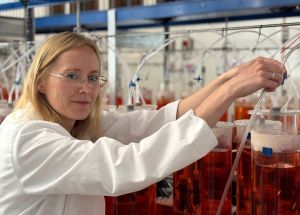The double life of paludibiomass through cascading-use
Environmental engineer Dr. Karina Brown aims to unlock the diverse utilization potential of paludibiomass through cascading-use. Used as bedding in barns, this plant material – enhanced by poultry manure – becomes a promising feedstock for biogas plants. The possibility to generate additional income through the cascading-use of paludibiomass could improve the profitability of paludiculture for farmers, which is currently under investigation

Ms. Dr. Brown, paludibiomass from the poultry farm for energy in agricultural biogas plants – how do you research this? Do you get a load of manure delivered every day?
No, not quite. Pellets were produced from one ton of paludihay using various processing methods at the Leibniz Institute for Agricultural Engineering and Bioeconomy e.V. (ATB) in Potsdam within the BLuMo moor pilot project, with which we cooperate as WetNetBB. This work was supported by close cooperation with a regional farmer from the Rhinluch region. On a poultry farm, pellets of varying quality were then used as bedding material. Once the pellets had been saturated with the animal excrement, samples of the bedding material were taken from the experimental barn. The biogas production potential was then determined in the ATB laboratory. Worldwide standardized measurement methods exist for this purpose.
Biomass from peatlands is relatively low in energy, but could become an energy “supersource” when combined with poultry manure—why is that?
Perhaps not a “supersource”, but certainly an interesting alternative to other currently used agricultural biogas feedstocks. That is at least our starting point. Energy production from paludibiomass is no easy task, as previous research has shown. This is related both to the chemical structure of the biomass itself, which is difficult to digest, and to its chemical composition. This, in turn, affects not only the quantity but also the quality of the biogas produced. Biogas consists mainly of carbon dioxide and methane. Our focus is on the methane, the energy carrier in biogas. We aim to maximize its yield, which is also achieved through its utilization as bedding in livestock farming. As our results show, using bedding material enriched with animal excrement improves the stability of the methane production process.
But why not simply put the paludibiomass in the barn as straw? Doesn't the intermediate step of pelleting make it more complicated for farmers?
There are several advantages: Pellets absorb liquids much better than straw. This means that bedding in the form of pellets doesn't need to be exchanged as often – a clear benefit for farmers. Thanks to pretreatment step, pelleted bedding is also microbiologically safe and can therefore be used safely in animal husbandry. Furthermore, a pellet production process allows us to obtain a product that is easier to store and transport without any loss of quality. Pelletizing offers farmers greater flexibility and the opportunity to diversify their income. They can sell some of the pellets or use the press to produce other pellet products, such as fuel pellets.
Would this concept be financially viable?
The economic viability of cascading-use in the presented form must be examined on a case-by-case basis. Whether such a utilization ultimately proves worthwhile depends, among other things, on the quality of the pellets produced. In other words, the crucial question is whether the energy required for pelleting and the energy recovered from bedding pellets at least balance each other out. To determine this, the anaerobic digestion process must first be optimized. Only then we can say whether a cascading-use of paludibiomass is economically viable.
Reed, cattail, sedges – what actually goes into the tank for your experiment?
In our project WetNetBB we focus on the wet meadows biomass, which is very heterogeneous. The vegetation depends on the water level and is shaped by natural succession. This is not material from just a single plant species.
How did you get into this research?
During my PhD in Poland, I already dealt with various energy crops that are considered hardly digestible in biogas production. My research experience shows that this poor digestibility can be improved, for example through pretreatment, cascading-use, or co-digestion. Given the associated possibilities - such as extended usage - it makes perfect sense to examine this topic in the context of paludiculture.
What outcome would you like to see for your research?
I'm not here to make any wishes. As a scientist, I provide farmers with a solid foundation based on reliable research results, enabling them to make informed decisions about whether such cascading-use is an attractive business model for them or not.
Dr. Karina Brown investigates at the Leibniz Institute for Agricultural Engineering and Bioeconomy e.V. (ATB) as part of the WetNetBB project the use of paludibiomass in existing agricultural biogas plants. This work is carried out in close cooperation with the BLuMo project on the material use of paludibiomass.











